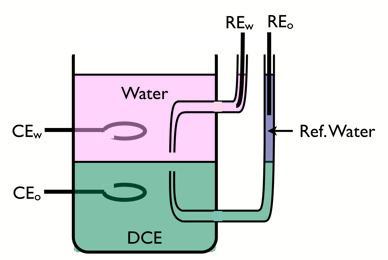 | ||
In electrochemistry, ITIES is an acronym for the "interface between two immiscible electrolyte solutions". Usually, one electrolyte is an aqueous electrolyte composed of hydrophilic ions such as NaCl dissolved in water and the other electrolyte is a lipophilic salt such as tetrabutylammonium tetraphenylborate dissolved in an organic solvent immiscible with water such as nitrobenzene, or 1,2-dichloroethane.
Contents
- Charge transfer reactions of an ITIES
- Four Electrode cell
- Ion partition coefficient and ion distribution coefficient
- Distribution potential
- References
An ITIES is an electrochemical interface that is either polarisable or polarised. An ITIES is said polarisable if one can change the Galvani potential difference, or in other words the difference of inner potentials between the two adjacent phases, without noticeably changing the chemical composition of the respective phases (i.e. without noticeable electrochemical reactions taking place at the interface). An ITIES system is said polarised if the distribution of the different charges and redox species between the two phases determines the Galvani potential difference.
Charge transfer reactions of an ITIES
Three major classes of charge transfer reactions can be studied at an ITIES:
The Nernst equation for an ion transfer reaction reads
where
The Nernst equation for a single heterogeneous electron transfer reaction reads
where
Four-Electrode cell
To study charge transfer reactions of an ITIES, a four-electrode cell is used.
Two reference electrodes are used to control the polarisation of the interface, and two counter electrodes made of noble metals are used to pass the current. The aqueous supporting electrolyte must be hydrophilic, such as LiCl, and the organic electrolyte must be lipophilic, such as tetraheptylammonium tetra-pentafluorophenyl borate.
Ion partition coefficient and ion distribution coefficient
Contrary to a neutral solute, the partition coefficient of an ion depends of the Galvani potential difference between the two phases:
Distribution potential
When a salt is distributed between two phases, the Galvani potential difference is called the distribution potential and is obtained from the respective Nernst equations for the cation C+ and the anion A– to read
where γ represents the activity coefficient.
